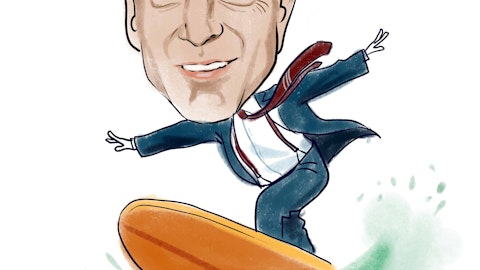Regarding capital allocation, we opportunistically repurchased $100 million of shares during the quarter, reflecting our commitment to delivering consistent returns to our shareholders. We still have $775 million remaining under last year’s repurchase authorization. And as we have said, we will remain dedicated to returning capital to shareholders in aligning with our overarching goal of compounding free cash flow per share. We remain committed to maintaining an investment-grade credit profile. We ended the quarter with cash of $1.14 billion and gross debt of $2.9 billion. Our Q1 net debt to adjusted EBITDA of approximately 1.2x is a clear indication of the continued strength of our balance sheet. As of the end of Q1, approximately 35% of our debt is tied to floating rate debt, and our weighted average interest rate was approximately 5.1%.
Finally, with our strong balance sheet and free cash flow, we remain committed to our quarterly dividend. The Board has authorized an 11.5% increase to $0.29 per quarter, and our quarterly dividend will be paid on March 22. With this, we have increased our dividends each year since 2018, driving a nearly 12% dividend CAGR over that period. Now I will turn it back to Bob.
Robert Pragada: Thank you, Claudia. Turning to Slide 10. We continue to be energized as interest in our science-based digitally-enabled solutions remains robust as clients engage Jacobs to solve their most complex challenges. Internally, we remain focused on execution and continuing to deliver against our operational and financial objectives. We reiterate our outlook for fiscal 2024 adjusted EBITDA of $1.53 billion to $1.60 billion, with adjusted EPS of $7.70 to $8.20, representing 9% and 10% growth at midpoints, respectively. This guidance incorporates Q1 adjusted EPS of $2.02 and as Claudia shared, a 26% to 27% adjusted effective tax rate each quarter for the remainder of this fiscal year. Though we expect a heavier than normal cost structure until separation, particularly in [indiscernible], we anticipate accelerating EPS growth in the second half of the fiscal year.
In closing, we’ve maintained focus on standing up both independent Jacobs and CMS for success while streamlining and optimizing our operating model and positioning both companies for long-term value creation. Operator, we will now open the call for questions.
Operator: [Operator Instructions]. We’ll go first to Andy Wittmann at Baird.
Andrew Wittmann: Oh, great. I guess for those who are unfamiliar, including myself to some extent here, on the SG&A reallocation into the segment, I think what you’re saying there is if — in these reimbursable public sector customers that you have, if you can show — if it’s in the segment, you can get paid basically for those costs. I think that’s the mechanism. I just wanted to clarify that. And maybe, Claudia, could you talk about what the dollar amount on an annual basis is on the reallocation from the SG&A line into the segment? .
Robert Pragada: Yes, Andy, it’s a great question. It’s actually a nice lead-in. So your assessment of that recoverability is correct. And if you just kind of just moment — for a moment, kind of pre planning for the separation and outpost. Pre, we had a lot of shared costs. And so the direct applicability through the segment was not as clear. And since we started this, we had a great opportunity to now have direct line of sight to where these are being applied. Hit it right in the beginning of the audit cycle, the government audit cycle in Q1 and now have the full year of applying those costs. So that’s — that’s correct. Now on the full year amount, it would be the $17 million that we identified this year — I’m sorry, this quarter multiplied by 4. But remember, over each quarter that goes down because of the recoverability effect. Did that make sense?
Andrew Wittmann: Yes, I guess it does. The — I mean the — so I guess, with — in the corporate unallocated reported at $59 million for the quarter, I guess what you’re saying is unadjusted, that number would have been $17 million higher. In other words, that $59 million benefits from the $17 million that was moved?
Robert Pragada: That’s correct.
Andrew Wittmann: Can you just talk about — underlying that business — or underlying the underlying costs for the corporate unallocated. Were there any other costs that are notable in terms of separation or other things through the SG&A line right now? Certainly, there’s been these efficiency initiatives, Bob, that you’ve talked a lot about. But is there anything else we should know about that wasn’t excluded from that corporate unallocated line?
Robert Pragada: No. No, the $9 million of transition costs took it to $59 million and then the $17 million that we were able to, from a positive standpoint, move into P&PS and get recoverability on it was it. I will say, Andy, we are making progress on kind of our overall cost optimization or reductions that we started at the beginning of the year, to where we’ll be right on plan of what we identified last quarter.
Operator: We’ll go next to Mike Dudas at Vertical Research Partners.
Michael Dudas: Maybe you can share a little bit more on PP&S relative to the pipeline as it stands today. You talked a little bit in your prepared remarks about margin improvement in backlog. How does that track as we go through fiscal year 2024? Is the — are you getting better share on higher-margin projects, maybe early consulting advisory relative to design work in some of these projects? And what areas do you anticipate some of the better revenue and booking growth in the P&PS segment as we move through ’24?





